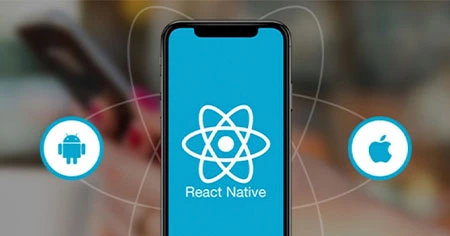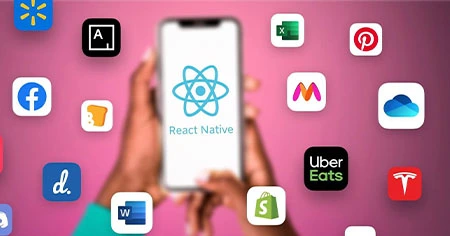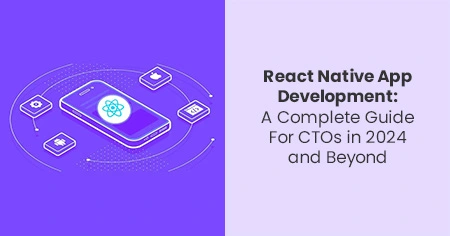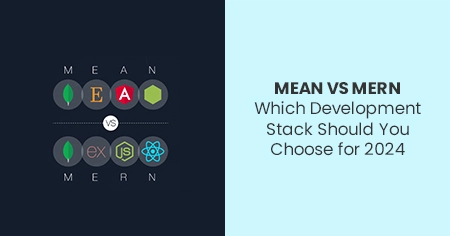According to Google Trends, the number of web searches for "hire React Native developer" in the United States alone has increased 300% in the last year. The React Native framework maintains its lead among the best technologies for developing cross-platform applications.
In 2022 and beyond, React Native will see several improvements, including new architecture and libraries. So what has changed after all? This guide will cover the most important aspects of React Native development, including a Comprehensive Guide for App Development and CTOs in 2024 and beyond.
What is React Native App Development?

React Native is a cross-platform mobile app development framework developed by Facebook. It combines ReactJS and JavaScript to create native-looking mobile apps for Android and iOS. Instead of relying on platform-specific languages such as Swift or Java, React Native uses native components wrapped in JavaScript. This allows developers to write code once and deploy it to both platforms, saving resources and time.
Here is what CTOs should know.

Whether you work with code daily or closely monitor your team's tech strategy, you've probably noticed that the React Native ecosystem is rapidly evolving. It is evolving from one of many app frameworks to a potential app and web development benchmark, and everyone is looking ahead to what will be next.
With all the talk about new architecture, languages, and product suites unlocking so much of React Native's potential, many changes are in the works for 2024.
If React Native is on your radar, you're planning to switch, or you're already using it and don't want to be caught off guard, you should know what's coming and how to start planning for it now.
Define your current needs.

As a CTO, you are well aware of your company's needs and goals, whether small or large. But what do you do when deciding which developers to hire on a tight budget and timeline?
Start by identifying the project's technical scope and goals. What kind of application are you building? Is it a mobile or online app? Which features are required, and which are optional?
Once you understand the project, consider the required technical skills and experience. This could include knowledge of specific programming languages, frameworks, or libraries. This is when you must select a framework for your future App Development and CTOs and developers who can work with it. For example, React Native uses a single codebase for iOS and Android applications, reducing development costs and time. It also has a fast and responsive user interface because it is built with native components rather than web views. This ensures that applications run smoothly and provide a better user experience.
React Native provides an efficient development process, platform compatibility, and an easily accessible user interface.
React Native is widely used for mobile applications:

mobile applications
With React Native, you can deploy a single code base to iOS and Android. This results in a more consistent UI, meaning you only need to find a team of developers with a specific skill set to create what you require. It is not a legally binding contract either.
Rich UI Components
React Native includes many pre-built UI components and libraries that help developers quickly and efficiently create complex and visually appealing app interfaces.
Development speed
Compared to other cross-platform frameworks such as Flutter, React Native stands out for two reasons: lightning-fast over-the-air updates enabled by Expo and Expo Application Services. These are cloud services designed specifically for React-Native that accelerate development while maintaining stability and consistency that generic cloud systems struggle to match.
Large Developer Community
The thriving and active React Native developer community offers plenty of support, resources, and libraries to help with any development challenge.
Performance
React Native provides native-level performance, and well-designed code generates buttery-smooth user interfaces. Pure native implementations may outperform React Native on occasion, but there are few practical applications. Meanwhile, hybrid technologies like Ionic and Xamarin use the web and cannot match the performance of native components. React Native apps compile to native code underneath, allowing you to easily interact with device features such as the camera, microphone, and accelerometer.
Code Reusability
The benefit of React Native is its ability to reuse code across platforms. This saves money and time when developing separate native apps for Android and iOS.
Open-source support
React Native offers robust open-source support. This ensures that documentation remains relevant and the framework continues improving, as evidenced by recent additions such as Solito. Frameworks like Flutter need more community support, necessitating more frequent custom development, which incurs higher costs.
React Native is the framework of the future and the now:

React Native is in its best position ever. It is now platform agnostic across iOS, Android, and the Web, and the friction that previously prevented seamless cross-platform solutions is being eliminated. The framework as a whole is rapidly evolving due to a strong community. It is becoming more stable across the board while supporting development workflows that are getting faster and faster. Flutter may be popular among hobbyists, but React Native and Expo are becoming the de facto standards for production-ready apps.
Conclusion
We hope this extensive React Native development guide has provided readers with a thorough understanding of the framework's benefits, architecture, and costs. React Native has established itself as a powerful tool for developing cross-platform mobile applications, and its numerous advantages have compelled many developers and businesses to choose it.








